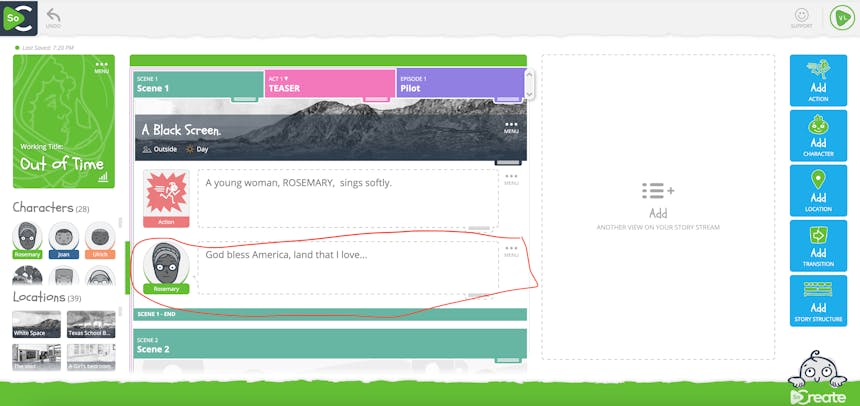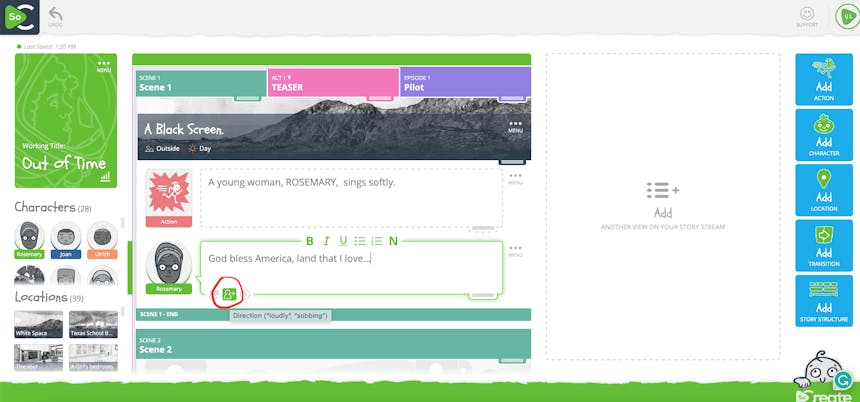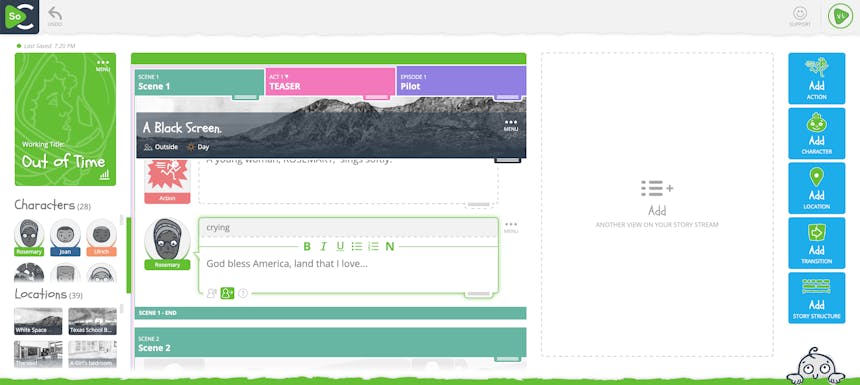With one click
Export a perfectly formatted traditional script.
Dialogue is one of the most important components of any screenplay. Dialogue advances the plot, builds personality, and breathes life into your characters.
However, dialogue is more than just written words. How do you express how the words should be said? How do you inform an actor of how their character is speaking a certain line?
Keep reading to discover how and when to add dialogue direction to a screenplay.
Dialogue direction, also known as stage direction, actor direction, or personal direction, is the part of the script that tells a writer how a line should be delivered.
Dialogue direction might include details like volume, tone of voice, the specific action that should accompany the line or any other details that can help the actor bring their character to life.
Experts caution that dialogue direction should be used sparingly within a screenplay. We'll get into why that is in the dos and don'ts below.
SoCreate's software makes adding dialogue direction to your screenplay quick, easy, and painless. It's also more fun than writing in legacy screenwriting software because SoCreate shows the emotion on your characters' faces!
Click on the dialogue stream that you want to edit. I circled the one I'm selecting.

Below it, click on the icon of a person and an arrow circled again below.

Once you click that, a box will appear above the selected dialogue, and you can go ahead and type in how you want the character to deliver the line.

If an applicable version of the direction you gave exists within the software, it will change your character's icon to emote accordingly! Pretty cool, huh?
When you're done, just click outside of the dialogue stream item to save the change!
In a traditional screenplay, dialogue direction should be placed on a line above the dialogue. It's usually written in parenthesis that precedes the dialogue. For example, it might look like:
(shouting)
How dare you!
Dialogue direction can also be used to signal that a character is continuing to speak. In that case, it might look like:
There's gold in that old mine.
Jim takes a long sip from his drink.
(continuing)
So, you see, I won't be leaving town anytime soon.
When it comes to using dialogue direction in your screenplay, there are some things you will want to keep in mind! Here are some dialogue direction dos and don'ts to consider:
If a certain action or gesture is important to the scene, you should use a dialogue direction to make the actor aware of it.
Too many dialogue directions can cause distraction or confusion when reading your script. Be sure only to use dialogue directions when it's appropriate.
Dialogue direction should be short and precise. Be as brief and specific as possible. If you can't express what you're trying to say in a word or two, consider writing the direction as an action line instead.
It's important to be specific in you're writing, but it's also important not to micromanage. Have you ever received feedback telling you not to direct from the page? Using too many dialogue directions too often can feel like you're trying to direct the actors. Allow the actors room for their own choices and interpretations to shine.
Be mindful that your script isn't only going to be read by potential actors. It needs to be readable for anyone working on the project. Bogging down a screenplay with too many dialogue directions can make for a frustrating or distracting read. Keep all readers in mind and save dialogue directions for when they're strictly necessary.
Export a perfectly formatted traditional script.


Dialogue direction can be an important part of any screenplay. Hopefully, this blog was able to give you a better idea of how and when to use dialogue directions. They can inform actors about their characters and how to bring them to life. Remember that dialogue directions should be kept to a minimum to allow actors to develop their own opinions and ideas for a character. Aim to be specific in your directions, but don't overdo it. Good luck, and happy writing!